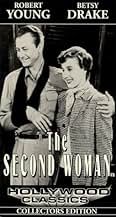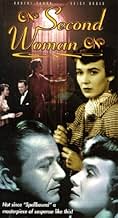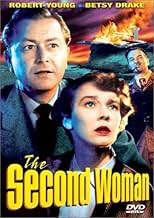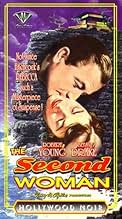NOTE IMDb
6,3/10
1,5 k
MA NOTE
Ajouter une intrigue dans votre langueIn flashback from a 'Rebecca'-style beginning: Ellen Foster, visiting her aunt on the California coast, meets neighbor Jeff Cohalan and his ultramodern clifftop house.In flashback from a 'Rebecca'-style beginning: Ellen Foster, visiting her aunt on the California coast, meets neighbor Jeff Cohalan and his ultramodern clifftop house.In flashback from a 'Rebecca'-style beginning: Ellen Foster, visiting her aunt on the California coast, meets neighbor Jeff Cohalan and his ultramodern clifftop house.
- Réalisation
- Scénario
- Casting principal
Jason Robards Sr.
- Stacy Rogers
- (as Jason Robards)
Jimmie Dodd
- Mr. Nelson
- (as Jimmy Dodd)
Smoki Whitfield
- Porter
- (scènes coupées)
Walter Bacon
- Country Club Guest
- (non crédité)
Vince Barnett
- Giovanni Strobini
- (non crédité)
Paul Bradley
- Country Club Guest
- (non crédité)
Avis à la une
It's opening speech tries far too hard to evoke associations with 'Rebecca' (it even features one of the original cast), and it also shoehorns in references to 'Suspicion' and 'Spellbound'. But it actually works perfectly own on it's own terms - with a bit of postwar psychology thrown in and Tchaikovsky on the soundtrack - and ironically harks forward towards later Hitchcocks (notably 'North by Northwest') with it's hero and heroine meeting cute on a train and the hilltop Frank Lloyd Wright-style house that serves as a backdrop to some of the drama.
A chicly attired Betsy Drake - ironically Mrs Cary Grant at the time - provides an attractive and robust female lead.
A chicly attired Betsy Drake - ironically Mrs Cary Grant at the time - provides an attractive and robust female lead.
This interesting psychological drama has a number of strengths that more than make up for the low-budget look and a few minor flaws. The story is full of tension and dramatic possibilities, and things are built up nicely, with the flashback opening and a number of the plot elements frequently reminding you of "Rebecca". It's not really on a par with that story, or with the Hitchcock film version, but it has the same kind of psychology-driven story that takes some skill to tell.
Robert Young plays a talented architect whose life and mental stability have been troubled by a recent tragedy. Young is well cast, since in his earlier years he came across well as this kind of character, who is likable but whose behavior raises a lot of questions. Betsy Drake was an interesting choice for the female lead, emphasizing sincerity, intelligence, and loyalty rather than the glamour and mystery that often characterize noir heroines. Florence Bates also works well as the aunt of Drake's character, though it would have been nice to see the script give her more to work with.
The past and present are tied together in an interesting and unpredictable plot. A more carefully scripted climactic sequence, bringing everything out in a more deliberate manner, would have topped it off even better. But even so, it remains among the better B-movies of its genre, and it makes for an hour and a half of good drama.
Robert Young plays a talented architect whose life and mental stability have been troubled by a recent tragedy. Young is well cast, since in his earlier years he came across well as this kind of character, who is likable but whose behavior raises a lot of questions. Betsy Drake was an interesting choice for the female lead, emphasizing sincerity, intelligence, and loyalty rather than the glamour and mystery that often characterize noir heroines. Florence Bates also works well as the aunt of Drake's character, though it would have been nice to see the script give her more to work with.
The past and present are tied together in an interesting and unpredictable plot. A more carefully scripted climactic sequence, bringing everything out in a more deliberate manner, would have topped it off even better. But even so, it remains among the better B-movies of its genre, and it makes for an hour and a half of good drama.
What this b&w noir has going for it is the scenic grandeur of the central California coastline. The roiling sea and rocky outcrops, along with the ultra-modern (circa 1950) cliff house, provide an unusual backdrop to this psychological drama. Bad things keep happening to architect Jeff (Young) for no apparent reason, starting with the highway death of his wife. Enter Ellen (Drake) who seeks to uncover the mystery, though the finger of guilt begins to point at a grieving Jeff who may now be unhinged.
Both the script and the staging are excellent until the climax, which should have been reconsidered from both ends, especially the ludicrous gunshot that seemingly takes minutes to register. Drake's an appealing actress and projects intelligence in the part. At the same time, she's unusual for a decade that emphasized buxom sex-goddesses, which she definitely is not. She and Young do make a well-matched screen couple. However, Young's performance is rather strange. I don't know if he was reaching for a particular effect, but his low-key demeanor never changes despite the many provocations. Unfortunately, it borders on both the boring and the implausible.
Nonetheless, it's an intriguing mystery and a real treat for the eye thanks to cinematographer Hal Mohr. Also, I can't help noticing that Harry Popkin produced this film, along with the noir classic DOA (1950) and such imaginative B-movies as The Well (1951) and The Thief (1952). I expect it was he who insisted on the scenic locations for this film, proving that noir need not be confined to gritty urban settings. Anyway, I think it's fair to surmise that Popkin was a producer, unlike many, who understood the artistic side of movie-making. It shows here.
Both the script and the staging are excellent until the climax, which should have been reconsidered from both ends, especially the ludicrous gunshot that seemingly takes minutes to register. Drake's an appealing actress and projects intelligence in the part. At the same time, she's unusual for a decade that emphasized buxom sex-goddesses, which she definitely is not. She and Young do make a well-matched screen couple. However, Young's performance is rather strange. I don't know if he was reaching for a particular effect, but his low-key demeanor never changes despite the many provocations. Unfortunately, it borders on both the boring and the implausible.
Nonetheless, it's an intriguing mystery and a real treat for the eye thanks to cinematographer Hal Mohr. Also, I can't help noticing that Harry Popkin produced this film, along with the noir classic DOA (1950) and such imaginative B-movies as The Well (1951) and The Thief (1952). I expect it was he who insisted on the scenic locations for this film, proving that noir need not be confined to gritty urban settings. Anyway, I think it's fair to surmise that Popkin was a producer, unlike many, who understood the artistic side of movie-making. It shows here.
I really enjoyed this film. It has a fairly believable premise. I do have a little trouble with the self-sacrifice angle and the idea of taking things to the grave that could be dealt with, but it has lots of suspense and a cool ending. Robert Young is carrying around a secret. He is being daily harassed by someone. His dog is killed, his house is burned, his horse is harmed (to the point where it needs to be destroyed), and his livelihood (as an architect) is being compromised. He meets a young woman who makes him happy, but she can't convince him to come clean. There is a plot to portray him as psychotic (actually paranoid), He seems to have some handle on everything but won't say what it is. There is excellent cinematography. The pacing is quite good. I have to admit I never suspected what was going on. It's a captivating film. The acting is quite good. Oh, yes, as I see these films, I have seen the presence of Jimmy Dodd who was the head Mousketeer on the old Mickey Mouse Club show of the fifties. His acting portfolio is rather extensive though unimpressive.
Robert Young is one seemingly unlucky guy in "The Second Woman," a 1950 film also starring Betsy Drake, Morris Carnovsky, John Sutton, Florence Bates and Henry O'Neill. This was probably a 'B' noir; like "Shining Victory" and "The Uninvited," it is reminiscent of "Rebecca" - in fact, the beginning narration is basically a paraphrase of "Last night I dreamt I went to Manderlay." This film even goes so far as to have Florence Bates playing Drake's aunt; she was Mrs. DeWinter's employer in "Rebecca." Drake is Ellen Foster, a young woman en route by train to visit her aunt when she meets her aunt's attractive neighbor, Jeff Cohalon (Young). He's built a fantastic house that, her aunt informs Ellen, no one has ever been in. He built it for his bride-to-be, and she was killed in a car accident before the wedding. Since then, several people - his almost father-in-law, Ben (O'Neill), to whom Jeff is like a son, and a psychiatrist, Dr. Hartley (Carnovsky) have been concerned about Jeff. He seems absent-minded and moody. Then strange things begin to happen to Jeff - he has to shoot his horse when it breaks its leg apparently while in its stall; his dog dies; the color on a painting he owns suddenly fades; and roses he brings into the house die immediately. Ellen, who works with actuarial tables, is darn suspicious - there is too much bad luck, and either Jeff himself or someone who wants him destroyed is behind it.
"The Second Woman" is a decent film with good, if unexciting, acting. Robert Young made several noirs in the '40s, and he did them well - you really don't know here if he's sinister or if he's a victim. Drake is a bland costar. Carnovsky, O'Neill, Sutton and Bates give good support. Sutton strikes the right note as a man who hates Jeff.
Like dozens and dozens of post-World War II, there is an emphasis on psychology. Considering what our soldiers went through in World War II, it's not surprising that it was a hot topic. Here the big word is paranoia. But as anyone will tell you, just because you're paranoid doesn't mean someone's not out to get you.
"The Second Woman" is a decent film with good, if unexciting, acting. Robert Young made several noirs in the '40s, and he did them well - you really don't know here if he's sinister or if he's a victim. Drake is a bland costar. Carnovsky, O'Neill, Sutton and Bates give good support. Sutton strikes the right note as a man who hates Jeff.
Like dozens and dozens of post-World War II, there is an emphasis on psychology. Considering what our soldiers went through in World War II, it's not surprising that it was a hot topic. Here the big word is paranoia. But as anyone will tell you, just because you're paranoid doesn't mean someone's not out to get you.
Le saviez-vous
- AnecdotesAt the beginning of the movie, Robert Young's character tries to commit suicide by running his car engine in an enclosed garage. Then in flashback, the doctor says that he's concerned about Young's character's recurring bouts of depression. In real life, Young suffered from depression for decades, and tried to commit suicide in Westlake Village, CA in January 1991 by running a hose from his exhaust pipe into the interior of his car. Young called a tow truck to try to start his car. The driver noticed the hose, and contacted the police.
- GaffesIn the opening scene, Robert Young's character is discovered suffocated by heavy carbon monoxide in a sealed garage, but nobody else coming in the garage is affected by the deadly gas. Additionally, unless a car is burning oil or running very rich, exhaust fumes are not visible as was shown here. This reveals some type of smoke or vapor was used, not an actual auto exhaust.
- Citations
Jeff Cohalan: Let's see what the tea leaves say about you... there's a trick my grandmother taught me; she learned it from an old witch in Ireland.
Ellen Foster: And so you've been drinking coffee ever since.
- ConnexionsReferenced in This Movie Must Die!: The Second Woman (1950) (2021)
Meilleurs choix
Connectez-vous pour évaluer et suivre la liste de favoris afin de recevoir des recommandations personnalisées
- How long is The Second Woman?Alimenté par Alexa
Détails
- Date de sortie
- Pays d’origine
- Sites officiels
- Langues
- Aussi connu sous le nom de
- The Second Woman
- Lieux de tournage
- Société de production
- Voir plus de crédits d'entreprise sur IMDbPro
- Durée1 heure 31 minutes
- Couleur
- Rapport de forme
- 1.33 : 1
Contribuer à cette page
Suggérer une modification ou ajouter du contenu manquant

Lacune principale
By what name was La deuxième femme (1950) officially released in Canada in English?
Répondre


































